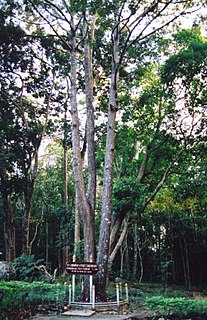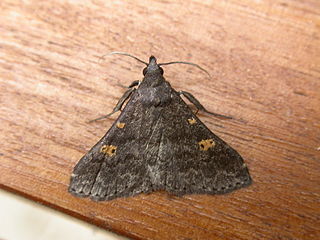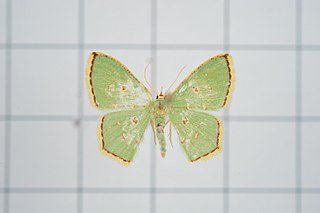
Adeona is a genus of bryozoans in the family Adeonidae. A typical example is the Australian species Adeona cellulosa that forms large colonies with bifoliate sheets containing numerous holes (fenestrae).

The flannel moths or crinkled flannel moths are a family of insects. They occur in North America and the New World tropics. The larvae are called puss caterpillars, and with their long hairs, resemble cotton balls. They have venomous spines that can cause a painful sting and inflammation lasting for several days. In some cases, the sting may cause headache, nausea, and shock-like symptoms. Perhaps the most notorious for stinging is the caterpillar of Megalopyge opercularis.

The Drepanidae is a family of moths with about 660 species described worldwide. They are generally divided in three subfamilies which share the same type of hearing organ. Thyatirinae, previously often placed in their own family, bear a superficial resemblance to Noctuidae. Many species in the Drepanid family have a distinctively hook-shaped apex to the forewing, leading to their common name of hook-tips.

Shorea is a genus of about 196 species of mainly rainforest trees in the family Dipterocarpaceae. The genus is named after Sir John Shore, the governor-general of the British East India Company, 1793–1798. The timber of trees of the genus is sold under the common names lauan, luan, lawaan, meranti, seraya, balau, bangkirai, and Philippine mahogany.

The Pyraloidea are a moth superfamily containing about 16,000 described species worldwide, and probably at least as many more remain to be described. They are generally fairly small moths, and as such, they have been traditionally associated with the paraphyletic Microlepidoptera.

The Limacodidae or Eucleidae are a family of moths in the superfamily Zygaenoidea or the Cossoidea; the placement is in dispute. They are often called slug moths because their caterpillars bear a distinct resemblance to slugs. They are also called cup moths because of the shape of their cocoons.

Callidulidae, the only known family of the superfamily Calliduloidea, is the family of Old World butterfly-moths, containing eight genera. They have a peculiar distribution, restricted to the Old World tropics of South East Asia to Australasia and Madagascar. The three subfamilies exhibit both day- and night-flying behaviour.

An antorbital fenestra is an opening in the skull that is in front of the eye sockets. This skull character is largely associated with archosauriforms, first appearing during the Triassic Period. Among extant archosaurs, birds still possess antorbital fenestrae, whereas crocodylians have lost them. The loss in crocodylians is believed to be related to the structural needs of their skulls for the bite force and feeding behaviours that they employ. In some archosaur species, the opening has closed but its location is still marked by a depression, or fossa, on the surface of the skull called the antorbital fossa.

Ennominae is the largest subfamily of the geometer moth family (Geometridae) with some 9,700 described species in 1,100 genera. They are usually a fairly small moths, though some grow to be considerably large. This subfamily has a global distribution. It includes some species that are notorious defoliating pests. The subfamily was first described by Philogène Auguste Joseph Duponchel in 1845.

Naarda is a large genus of erebid moths currently encompassing 108 species. Initially identified by Francis Walker in 1866, it is in the family Erebidae. Somewhat ruddy in appearance, this genus is distinguishable for its generally slender thorax and abdomen, and straight, porrect labial palpi. Most species are a light tan color, but shading can reach as deep as a charcoal, with muddy yellow, conspicuous reniform, orbicular stigmata featured on the forewings, sometimes reflected bilaterally superior.
Mantala is a monotypic moth genus in the subfamily Arctiinae. Its single species, Mantala tineoides, is found on Borneo. Both the genus and the species were first described by Francis Walker in 1862. The habitat consists of lowland and lower montane forests.

Sterrhinae is a large subfamily of geometer moths with some 3,000 described species, with more than half belonging to the taxonomically difficult, very diverse genera, Idaea and Scopula. This subfamily was described by Edward Meyrick in 1892. They are the most diverse in the tropics with the number of species decreasing with increasing latitude and elevation.

Thyas honesta is a species of moth of the family Noctuidae first described by Jacob Hübner in 1824. It is found in the Indian subregion, Myanmar, Thailand, Peninsular Malaysia, Sumatra, Sri Lanka, Borneo and on the Philippines.

Xyleutes strix is a moth of the family Cossidae. It is found in India, south-eastern Asia, Sundaland, the Philippines, Sulawesi, the Moluccas and New Guinea.

Asthenini is a tribe of geometer moths under subfamily Larentiinae first described by Warren in 1893. The tribe has been combined with Eupitheciini in the past, most notably by Jeremy Daniel Holloway in his work The Moths of Borneo.

The Erebinae are a subfamily of moths in the family Erebidae erected by William Elford Leach in 1815. Erebine moths are found on all continents except Antarctica, but reach their greatest diversity in the tropics. While the exact number of species belonging to the Erebinae is not known, the subfamily is estimated to include around 10,000 species. Some well-known Erebinae include underwing moths (Catocala) and witch moths (Thermesiini). Many of the species in the subfamily have medium to large wingspans, up to nearly 30 cm in the white witch moth, which has the widest wingspan of all Lepidoptera. Erebine caterpillars feed on a broad range of plants; many species feed on grasses and legumes, and a few are pests of castor bean, sugarcane, rice, as well as pistachios and blackberries.

Abaciscus costimacula is a species of moth belonging to the family Geometridae. It was described by Alfred Ernest Wileman in 1912. It is known from Taiwan, China, Sumatra, Peninsular Malaysia and Borneo.

Abaciscus tristis is a species of moth belonging to the family Geometridae, and the type species of the genus Abaciscus. It was described by Arthur Gardiner Butler in 1889. It is known from the Himalaya, western and southern China, Taiwan and Borneo.

Hypochrosis hyadaria is a geometer moth in the subfamily Ennominae described by Achille Guenée in 1857. The species has a wide range from India, Sri Lanka through Southeast Asia.

Comostola subtiliaria is a moth of the family Geometridae first described by Otto Vasilievich Bremer in 1864. It is a widespread species which is found in Korea and adjacent parts of Siberia, Japan, Borneo, Sumatra, India, South China, Taiwan, Borneo, Sumatra, and Sri Lanka.



















